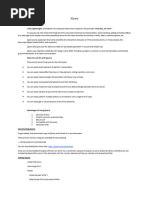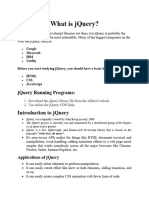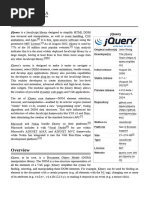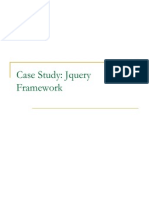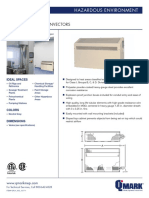0 ratings0% found this document useful (0 votes)
34 viewsLect 18 Quick Overview To JQuery
The document provides an overview of jQuery, explaining that it is a JavaScript library that makes JavaScript code shorter, faster and cross-browser compatible by providing methods to select elements, handle events, perform animations and AJAX requests. It discusses jQuery selectors, events, and categories of functionality including manipulating HTML, CSS, forms, effects and more. Examples are provided of using jQuery for common tasks like hiding/showing content and animations.
Uploaded by
AqsaCopyright
© © All Rights Reserved
Available Formats
Download as PDF, TXT or read online on Scribd
0 ratings0% found this document useful (0 votes)
34 viewsLect 18 Quick Overview To JQuery
The document provides an overview of jQuery, explaining that it is a JavaScript library that makes JavaScript code shorter, faster and cross-browser compatible by providing methods to select elements, handle events, perform animations and AJAX requests. It discusses jQuery selectors, events, and categories of functionality including manipulating HTML, CSS, forms, effects and more. Examples are provided of using jQuery for common tasks like hiding/showing content and animations.
Uploaded by
AqsaCopyright
© © All Rights Reserved
Available Formats
Download as PDF, TXT or read online on Scribd
You are on page 1/ 8
Lecture 18 1
Quick Overview to JQuery
Mr. Mubashir Ali
Lecturer (Dept. of Computer Science)
dr.mubashirali1@gmail.com
jQuery is a library of helper functions that are cross browser–
compatible. 2
It is an open source add-in that provides an easy, browser-agnostic
means for writing JavaScript.
jQuery is written in JavaScript, so it is JavaScript.
Make your JavaScript code shorter, faster and cross browser.
Manipulate your HTML, like showing or hiding something from the
page.
Handles events – it can do something when a user click a button or
any other activity a user can do with a mouse.
Animation – for example make a part of your page fade in, fade out
or just simply make something move.
AJAX – do a server request without refreshing your whole web page
JQuery Selectors 3
The most important purpose of jQuery is: select elements and do
some action on those selected elements.
The jQuery selectors allow you to search or select HTML elements
and then perform intended action on those.
Selectors in jQuery start with: $()
For example: $(‘tag_name’) , $(“#ID”), $(“.class”)
Note: Run Jquery when DOM is ready I;e;
$(document).ready( )
4
Categories of functionality jQuery Provides
Ajax (Asynchronous JavaScript and XML ) Methods that provide
synchronous and asynchronous calls to the server
Attributes Methods that get and set attributes of document object
model (DOM) elements
Callbacks object An object that provides many methods for
managing callbacks
Core Methods that provide core jQuery functionality
CSS Methods that get and set CSS-related properties
Data Methods that assist with associating arbitrary data with DOM
elements
Deferred object A chainable object that can register multiple
callbacks into call-back queues and relay the success or failure
state of any synchronous or asynchronous functions
5
Dimensions Helper methods for retrieving and setting DOM element
dimensions
Effects Animation techniques that can be added to your webpage
Events Methods that provide the ability to register code to execute
when the user interacts with the browser
Forms Methods that provide functionality when working with form
controls
Offset Methods for positioning DOM elements
Selectors Methods that provide the ability to access DOM elements
by using CSS selectors
Traversing Methods that provide the ability to traverse the DOM
Utilities Utility methods This lesson only scratches the surface of
jQuery’s capabilities, but subsequent lessons use jQuery whenever
possible.
6
Forms Methods that provide functionality when working with form
controls
Offset Methods for positioning DOM elements
Selectors Methods that provide the ability to access DOM
elements by using CSS selectors
Traversing Methods that provide the ability to traverse the DOM
Utilities Utility methods This lesson only scratches the surface of
jQuery’s capabilities, but subsequent lessons use jQuery
whenever possible.
JQuery Events 7
$("button").click(function(){
// do something when user click the button
});
$("form").submit(function(){
// do something when user submits a form
});
$("#myDiv").hover(function(){
// do something when user hover an HTML element
});
$("#myTextbox").keyup(function(){
// do something when user types on a textbox with ID
myTextbox
Class Practical Examples 8
Hide Show Content on Button Click
Slide Down & Slide Up Content on Click
Toggle & Fade Text on Button Click
Animations on Click
You might also like
- Power Transformers: Three-Phase Compartmental Padmounted Transformer Installation and Maintenance InstructionsNo ratings yetPower Transformers: Three-Phase Compartmental Padmounted Transformer Installation and Maintenance Instructions12 pages
- CHAPTER - 3 - LECTURE NOTES - ON - JqueryNo ratings yetCHAPTER - 3 - LECTURE NOTES - ON - Jquery43 pages
- Jquery Introduction: What You Should Already KnowNo ratings yetJquery Introduction: What You Should Already Know26 pages
- jQuery For Beginners: jQuery JavaScript Library Guide For Developing Ajax Applications, Selecting DOM Elements, Creating AnimationsFrom EverandjQuery For Beginners: jQuery JavaScript Library Guide For Developing Ajax Applications, Selecting DOM Elements, Creating AnimationsNo ratings yet
- Active Browser Pages, Web Services, BasicsNo ratings yetActive Browser Pages, Web Services, Basics59 pages
- Introductiontowebarchitecture 090922221506 Phpapp01No ratings yetIntroductiontowebarchitecture 090922221506 Phpapp0160 pages
- 8622 Urdu Book Chapter 1 To 3 - RotatedNo ratings yet8622 Urdu Book Chapter 1 To 3 - Rotated39 pages
- SOMATOM - Go - Sim Basic Planning InformationNo ratings yetSOMATOM - Go - Sim Basic Planning Information10 pages
- Supplemental Parts Information Index: Allison MT (B) 640, 643, 650, 653 Series On-Highway Transmissions Parts Catalog100% (1)Supplemental Parts Information Index: Allison MT (B) 640, 643, 650, 653 Series On-Highway Transmissions Parts Catalog130 pages
- ECOPS Electronics Police Record Management System0% (1)ECOPS Electronics Police Record Management System4 pages
- 03 Lomozik Creep-Resisting Structural Steels For The Power Industry-The Past and The Present TimeNo ratings yet03 Lomozik Creep-Resisting Structural Steels For The Power Industry-The Past and The Present Time8 pages
- Method Statement For Installation of Epoxy Grout SleeveNo ratings yetMethod Statement For Installation of Epoxy Grout Sleeve5 pages
- Steel Construction Manual: Companion To The AiscNo ratings yetSteel Construction Manual: Companion To The Aisc280 pages
- Agriculture For Rwandan Schools - Student Book - Senior TwoNo ratings yetAgriculture For Rwandan Schools - Student Book - Senior Two200 pages
- 00 AGENDA Radioss Intro V2019 MAR29-2019No ratings yet00 AGENDA Radioss Intro V2019 MAR29-201922 pages
- Power Transformers: Three-Phase Compartmental Padmounted Transformer Installation and Maintenance InstructionsPower Transformers: Three-Phase Compartmental Padmounted Transformer Installation and Maintenance Instructions
- jQuery For Beginners: jQuery JavaScript Library Guide For Developing Ajax Applications, Selecting DOM Elements, Creating AnimationsFrom EverandjQuery For Beginners: jQuery JavaScript Library Guide For Developing Ajax Applications, Selecting DOM Elements, Creating Animations
- Introductiontowebarchitecture 090922221506 Phpapp01Introductiontowebarchitecture 090922221506 Phpapp01
- Supplemental Parts Information Index: Allison MT (B) 640, 643, 650, 653 Series On-Highway Transmissions Parts CatalogSupplemental Parts Information Index: Allison MT (B) 640, 643, 650, 653 Series On-Highway Transmissions Parts Catalog
- 03 Lomozik Creep-Resisting Structural Steels For The Power Industry-The Past and The Present Time03 Lomozik Creep-Resisting Structural Steels For The Power Industry-The Past and The Present Time
- Method Statement For Installation of Epoxy Grout SleeveMethod Statement For Installation of Epoxy Grout Sleeve
- Agriculture For Rwandan Schools - Student Book - Senior TwoAgriculture For Rwandan Schools - Student Book - Senior Two



